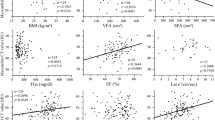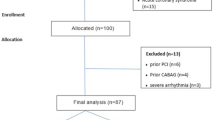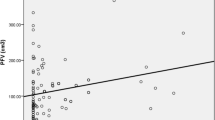Abstract
Epicardial adipose tissue (EAT) may play an important role for developing an unfavorable cardiovascular risk profile. However, it has not been investigated if EAT is associated with coronary atherosclerosis in non-obese patients. We aimed to evaluate whether EAT is related to coronary atherosclerosis in non-obese patients. Among the consecutive patients who underwent coronary CT angiography (CCTA) with an intermediate pretest likelihood for having coronary artery disease, we excluded the patients whose body mass index (BMI) was over 30 kg/m2 or whose CCTA image quality was not sufficient for the detection of coronary plaque. The remaining patients were divided into the normal and abnormal groups based on the presence of atherosclerotic plaques as seen on the CCTA images. The cardiovascular risk factors were matched between the two groups. Ultimately, 100 patients were included in the normal group and 100 patients were included in the abnormal group. The pericardial fat area was measured at the subaortic level of the heart on the axial CT images. The pericardial fat area was significantly larger in the abnormal group as compared to the normal group (18.1 ± 10.2 vs. 14.6 ± 8.7 cm2, P = 0.019). Even though the overweight patients (25 ≤ BMI < 30) were excluded, the pericardial fat area was still significantly larger in the patients with coronary atherosclerotic plaque as compared to that of the patients without coronary atherosclerotic plaque (18.7 ± 11.5 vs. 13.2 ± 7.9 cm2, P = 0.006). Pericardial fat was more abundant in the non-obese patients with coronary atherosclerosis as compared to that of the patients without coronary atherosclerosis, after controlling for the other cardiovascular risk factors.


Similar content being viewed by others
References
Kahn HS, Austin H, Williamson DF et al (1996) Simple anthropometric indices associated with ischemic heart disease. J Clin Epidemiol 49(9):1017–1024
Oppert JM, Charles MA, Thibult N et al (2002) Anthropometric estimates of muscle and fat mass in relation to cardiac and cancer mortality in men: the Paris Prospective Study. Am J Clin Nutr 75(6):1107–1113
Fox CS, Massaro JM, Hoffmann U et al (2007) Abdominal visceral and subcutaneous adipose tissue compartments: association with metabolic risk factors in the Framingham Heart Study. Circulation 116(1):39–48
Nakamura T, Tokunaga K, Shimomura I et al (1994) Contribution of visceral fat accumulation to the development of coronary artery disease in non-obese men. Atherosclerosis 107(2):239–246
Kobayashi H, Nakamura T, Miyaoka K et al (2001) Visceral fat accumulation contributes to insulin resistance, small-sized low-density lipoprotein, and progression of coronary artery disease in middle-aged non-obese Japanese men. Jpn Circ J 65(3):193–199
Miyawaki T, Abe M, Yahata K et al (2004) Contribution of visceral fat accumulation to the risk factors for atherosclerosis in non-obese Japanese. Intern Med 43(12):1138–1144
Jang Y, Kim OY, Ryu HJ et al (2003) Visceral fat accumulation determines postprandial lipemic response, lipid peroxidation, DNA damage, and endothelial dysfunction in nonobese Korean men. J Lipid Res 44(12):2356–2364
Mazurek T, Zhang L, Zalewski A et al (2003) Human epicardial adipose tissue is a source of inflammatory mediators. Circulation 108(20):2460–2466
Jeong JW, Jeong MH, Yun KH et al (2007) Echocardiographic epicardial fat thickness and coronary artery disease. Circ J 71(4):536–539
Iacobellis G, Pistilli D, Gucciardo M et al (2005) Adiponectin expression in human epicardial adipose tissue in vivo is lower in patients with coronary artery disease. Cytokine 29(6):251–255
Chaowalit N, Somers VK, Pellikka PA et al (2006) Subepicardial adipose tissue and the presence and severity of coronary artery disease. Atherosclerosis 186(2):354–359
Ahn SG, Lim HS, Joe DY et al (2008) Relationship of epicardial adipose tissue by echocardiography to coronary artery disease. Heart 94(3):e7
Ding J, Kritchevsky SB, Harris TB et al (2008) The association of pericardial fat with calcified coronary plaque. Obesity (Silver Spring) 16(8):1914–1919
de Vos AM, Prokop M, Roos CJ et al (2008) Peri-coronary epicardial adipose tissue is related to cardiovascular risk factors and coronary artery calcification in post-menopausal women. Eur Heart J 29(6):777–783
Baker AR, Silva NF, Quinn DW et al (2006) Human epicardial adipose tissue expresses a pathogenic profile of adipocytokines in patients with cardiovascular disease. Cardiovasc Diabetol 5:1
Iacobellis G, Assael F, Ribaudo MC et al (2003) Epicardial fat from echocardiography: a new method for visceral adipose tissue prediction. Obes Res 11(2):304–310
Iacobellis G, Ribaudo MC, Assael F et al (2003) Echocardiographic epicardial adipose tissue is related to anthropometric and clinical parameters of metabolic syndrome: a new indicator of cardiovascular risk. J Clin Endocrinol Metab 88(11):5163–5168
Iacobellis G, Ribaudo MC, Zappaterreno A et al (2004) Relation between epicardial adipose tissue and left ventricular mass. Am J Cardiol 94(8):1084–1087
Iacobellis G, Leonetti F (2005) Epicardial adipose tissue and insulin resistance in obese subjects. J Clin Endocrinol Metab 90(11):6300–6302
Wheeler GL, Shi R, Beck SR et al (2005) Pericardial and visceral adipose tissues measured volumetrically with computed tomography are highly associated in type 2 diabetic families. Invest Radiol 40(2):97–101
Taguchi R, Takasu J, Itani Y et al (2001) Pericardial fat accumulation in men as a risk factor for coronary artery disease. Atherosclerosis 157(1):203–209
Gorter PM, van Lindert AS, de Vos AM et al (2008) Quantification of epicardial and peri-coronary fat using cardiac computed tomography; reproducibility and relation with obesity and metabolic syndrome in patients suspected of coronary artery disease. Atherosclerosis 197(2):896–903
Leber AW, Becker A, Knez A et al (2006) Accuracy of 64-slice computed tomography to classify and quantify plaque volumes in the proximal coronary system: a comparative study using intravascular ultrasound. J Am Coll Cardiol 47(3):672–677
Gorter PM, de Vos AM, van der Graaf Y et al (2008) Relation of epicardial and pericoronary fat to coronary atherosclerosis and coronary artery calcium in patients undergoing coronary angiography. Am J Cardiol 102(4):380–385
Greif M, Becker A, von Ziegler F et al (2009) Pericardial adipose tissue determined by dual source CT is a risk factor for coronary atherosclerosis. Arterioscler Thromb Vasc Biol 29(5):781–786
Abbara S, Desai JC, Cury RC et al (2006) Mapping epicardial fat with multi-detector computed tomography to facilitate percutaneous transepicardial arrhythmia ablation. Eur J Radiol 57(3):417–422
Saura D, Oliva MJ, Rodriguez D et al (2008) Reproducibility of echocardiographic measurements of epicardial fat thickness. Int J Cardiol [Epub ahead of print]
Wang TD, Lee WJ, Shih FY et al (2009) Relations of epicardial adipose tissue measured by multidetector computed tomography to components of the metabolic syndrome are region-specific and independent of anthropometric indexes and intraabdominal visceral fat. J Clin Endocrinol Metab 94(2):662–669
Acknowledgments
We would like to sincerely thank the radiologic technologist, Sung-Hyun Lee, who participated in the image analysis with the authors.
Author information
Authors and Affiliations
Corresponding author
Rights and permissions
About this article
Cite this article
Yong, H.S., Kim, E.J., Seo, H.S. et al. Pericardial fat is more abundant in patients with coronary atherosclerosis and even in the non-obese patients: evaluation with cardiac CT angiography. Int J Cardiovasc Imaging 26 (Suppl 1), 53–62 (2010). https://doi.org/10.1007/s10554-009-9542-2
Received:
Accepted:
Published:
Issue Date:
DOI: https://doi.org/10.1007/s10554-009-9542-2




